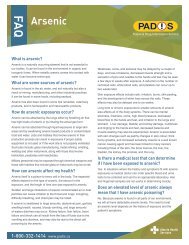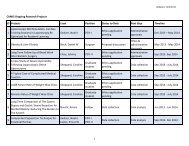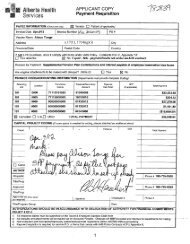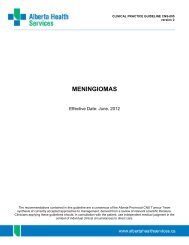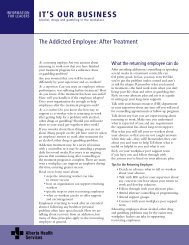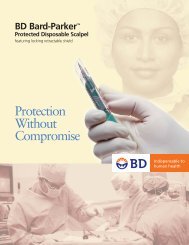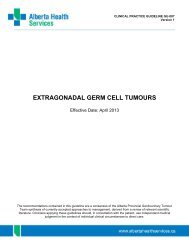taxanes in metastatic breast cancer - Alberta Health Services
taxanes in metastatic breast cancer - Alberta Health Services
taxanes in metastatic breast cancer - Alberta Health Services
You also want an ePaper? Increase the reach of your titles
YUMPU automatically turns print PDFs into web optimized ePapers that Google loves.
CLINICAL PRACTICE GUIDELINE BR-001<br />
ndomized women with<br />
or doxorubic<strong>in</strong> 75<br />
were anthracycl<strong>in</strong>e<br />
+ doxorubic<strong>in</strong> followed<br />
or median overall<br />
nths) or overall<br />
/m 2 + epirubic<strong>in</strong> 90<br />
g/m 2 q3 weeks x4. 20<br />
s), median<br />
57.6%). Quality of life<br />
arm. Sledge et al 16<br />
c<strong>in</strong>g of s<strong>in</strong>gle agents at<br />
doxorubic<strong>in</strong> 50 mg/m 2 sequential anthracycl<strong>in</strong>e followed by taxane (before progression).<br />
q3<br />
t progression, and<br />
2 16<br />
q3 weeks at progression. Just over<br />
ts <strong>in</strong> the s<strong>in</strong>gle agent arms actually did cross over to the alternate s<strong>in</strong>gle agent at<br />
progression. No significant differences were found for median overall survival between the comb<strong>in</strong>ation<br />
ime to failure was<br />
rm compared to either<br />
19, 20 Alba et al ra<br />
<strong>metastatic</strong> <strong>breast</strong> <strong>cancer</strong> to docetaxel 75 mg/m 2 + doxorubic<strong>in</strong> 50 mg/m 2 q3 weeks x6<br />
mg/m 2 q3 weeks x3 followed by docetaxel 100 mg/m 2 q3 weeks x3. 19 Women who<br />
pretreated and randomized to the comb<strong>in</strong>ation arm, received 3 cycles of docetaxel<br />
by 3 cycles of docetaxel 100 mg/m 2 q3 weeks. There were no significant differences f<br />
survival (21.8 versus 22.3 months), median time to progression (9.2 versus 10.5 mo<br />
response (51 versus 61%). Conte et al randomized participants to paclitaxel 200 mg<br />
mg/m 2 q3 weeks x8 or epirubic<strong>in</strong> 120 mg/m 2 q3 weeks x4 followed by paclitaxel 250 m<br />
There were no significant differences for median overall survival (20 versus 26 month<br />
progression free survival (10.8 versus 11 months) or overall response (58.5 versus<br />
assessment suggested better function<strong>in</strong>g and symptom control for the comb<strong>in</strong>ation<br />
were able to exam<strong>in</strong>e the issue of taxane/anthracycl<strong>in</strong>e comb<strong>in</strong>ation versus sequen<br />
progression. The three arms <strong>in</strong> this trial were as follows: paclitaxel 150 mg/m 2 +<br />
weeks, paclitaxel 175 mg/m 2 q3 weeks followed by doxorubic<strong>in</strong> 60 mg/m 2 q3 weeks a<br />
doxorubic<strong>in</strong> 60 mg/m 2 q3 weeks followed by paclitaxel 175 mg/m<br />
half of participan<br />
arm and either sequential s<strong>in</strong>gle agent arm (22 versus 22 versus 18.9 months). T<br />
significantly longer and response rate was significantly higher for the comb<strong>in</strong>ation a<br />
sequential s<strong>in</strong>gle agent arm.<br />
Summary statement<br />
The CCO recommendation was adapted.<br />
The current panel has acknowledged the results of 2 meta-<br />
analyses and one trial of docetaxel + doxorubic<strong>in</strong> versus paclitaxel + doxorubic<strong>in</strong> <strong>in</strong> support<br />
of this<br />
recommendation. Data on taxane/anthracycl<strong>in</strong>e comb<strong>in</strong>ations versus sequential s<strong>in</strong>gle<br />
agents was also<br />
considered.<br />
Recommendation #3<br />
Recommendations from exist<strong>in</strong>g guidel<strong>in</strong>es<br />
c axel are options. The<br />
CCO guidel<strong>in</strong>e takes the stance that the evidence for us<strong>in</strong>g docetaxel q3 weeks is more consistent and<br />
based on larger trials than the evidence for us<strong>in</strong>g paclitaxel q3 weeks. The CCO 6 The CCO<br />
suggests reserv<strong>in</strong>g<br />
weekly taxane regimens (options not specified) for those who are elderly, have a low performance status<br />
or would prefer avoid<strong>in</strong>g some of the toxicities associated with <strong>taxanes</strong> q3 weeks. The NICE guidel<strong>in</strong>e is<br />
non-directive <strong>in</strong> terms of which s<strong>in</strong>gle agent regimens can be considered.<br />
6 and NICE 7 guidel<strong>in</strong>es both suggest that s<strong>in</strong>gle agent docetaxel and pa lit<br />
6<br />
It was noted that the recent BCCA, 9 NCCN 10 and CECOG 11 statements also suggest that s<strong>in</strong>gle agent<br />
<strong>taxanes</strong> are options. BCCA 9 considers docetaxel q3 weeks and weekly, plus paclitaxel q3 weeks. NCCN 10<br />
considers both docetaxel and paclitaxel q3 weeks and weekly, plus nab-paclitaxel q3 weeks. CECOG 11 is<br />
non-directive <strong>in</strong> terms of which s<strong>in</strong>gle agent regimens can be considered.



